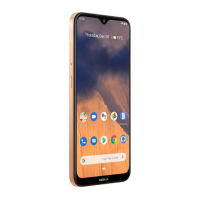
Do you have a question about the Nokia 2.3 and is the answer not in the manual?
| Form factor | Bar |
|---|---|
| Product color | Sand |
| Wi-Fi | Yes |
| 4G standard | LTE |
| 2G standards | GSM |
| 3G standards | WCDMA |
| SIM card type | MicroSIM |
| Wi-Fi standards | 802.11b, 802.11g, Wi-Fi 4 (802.11n) |
| Bluetooth version | 5.0 |
| SIM card capability | Dual SIM |
| 2G bands (primary SIM) | 850, 900, 1800, 1900 MHz |
| Mobile network generation | 4G |
| RAM type | LPDDR4X |
| RAM capacity | 2 GB |
| Compatible memory cards | MicroSD (TransFlash) |
| Maximum memory card size | 512 GB |
| Internal storage capacity | 32 GB |
| Screen shape | Flat |
| Display diagonal | 6.2 \ |
| Touch technology | Multi-touch |
| Touchscreen type | Capacitive |
| Display resolution | - pixels |
| Native aspect ratio | 19:9 |
| Processor cores | 4 |
| Processor model | Helio A22 |
| Processor family | MediaTek |
| Processor frequency | 2 GHz |
| Auto focus | - |
| Flash type | LED |
| Rear camera type | Dual camera |
| Front camera type | Single camera |
| Rear camera aperture number | 2.2 |
| Front camera aperture number | 2.4 |
| Rear camera resolution (numeric) | 13 MP |
| Front camera resolution (numeric) | 5 MP |
| Second rear camera resolution (numeric) | 2 MP |
| Subscription type | No subscription |
| USB version | 2.0 |
| USB connector type | Micro-USB |
| Headphone connectivity | 3.5 mm |
| Multimedia Messaging Service (MMS) | Multimedia Messaging Service (MMS) is a standard way to send messages that include multimedia content to and from a mobile phone over a cellular network |
| Themes | Wallpapers |
| Personalization | Icons, Menu, Shortcuts |
| Wireless charging | No |
| Personal info management (PIM) | Alarm clock, Calculator, Calendar |
| Platform | Android |
| Google applications | Google Maps, Google Play |
| App distribution platform | Google Play |
| Operating system installed | Android 9.0 |
| Talk time (3G) | - h |
| Battery capacity | 4000 mAh |
| Cables included | USB |
| Depth | 8.68 mm |
|---|---|
| Width | 75.41 mm |
| Height | 157.69 mm |
| Weight | 183 g |
Information on updating phone software for new features and performance.
Identifies physical keys and components of the phone.
Step-by-step guide to inserting SIM and memory cards.
Instructions on how to charge the phone's battery.
Guide to powering on and configuring the phone for the first time.
How to configure and manage dual SIM card usage.
Methods for securing and accessing the phone.
Explains basic touch gestures and screen interaction.
Customizing phone wallpaper and ringtones.
Managing and understanding phone notifications.
Adjusting audio levels for calls, media, and alarms.
Features for improving typing accuracy and speed.
Using the Google Assistant for voice commands and information.
Tips and settings to extend the phone's battery duration.
Features to make the phone easier to use for everyone.
How to listen to FM radio using the phone.
Making, answering, and managing phone calls.
Adding, organizing, and managing phone contacts.
Composing and sending text messages.
Setting up and using email accounts on the phone.
Connecting with friends through social networking apps.
Introduction to the phone's camera features for photos and videos.
Instructions for recording and managing videos.
Viewing, copying, and sharing media files.
Steps to connect to wireless networks.
Managing cellular data for internet access.
Navigating websites using the phone's browser.
Connecting and sharing with other devices wirelessly.
Setting up and using a Virtual Private Network connection.
Setting and updating the phone's date, time, and time zone.
Setting, modifying, and switching alarms on/off.
Managing appointments, events, and schedules.
Using Google Maps to locate places and navigate.
Managing offline maps for navigation without data.
Enabling and managing the phone's location features.
Downloading and installing applications from the Play Store.
Methods to manage storage and remove unnecessary files.
Instructions for installing system and app updates.
Creating backups of phone data and settings.
Performing a factory reset to restore default settings.
Checking and managing available phone storage space.
Uninstalling applications from the device.
Setting up screen lock methods like PIN, pattern, or password.
Using facial recognition for phone unlocking.
Modifying the SIM card's Personal Identification Number.
Information about PIN, PUK, and lock codes.
General safety guidelines for device usage.
Guidelines on when and where to power off the device.
Prioritizing driving safety and obeying traffic laws.
Guidelines for approved repairs and accessories.
Precautions to protect the device from moisture.
Handling glass parts and protecting hearing during use.
Specific Absorption Rate (SAR) and RF exposure information.
Understanding network costs and making emergency calls.
General maintenance and proper disposal instructions.
Details on batteries, chargers, and safe usage.
Safety regarding children and potential interference with medical devices.
Precautions for implanted devices and avoiding harmful content.
Safety in vehicles and potentially explosive environments.
Details on radio wave exposure and SAR compliance.
Information on copyright, DRM, and legal notices.